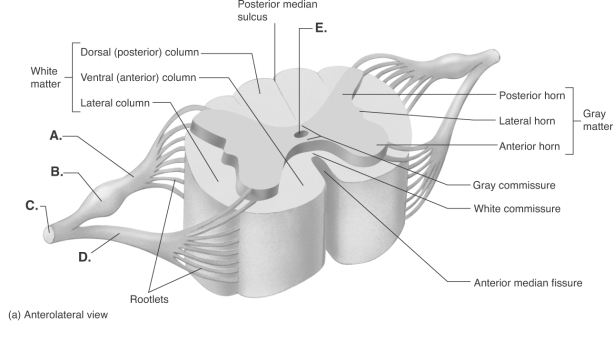A) maintain posture longer.
B) fall.
C) decrease muscle tension.
D) develop resistance in one limb and reduce resistance in the other.
E) hop.
G) C) and D)
Correct Answer

verified
Correct Answer
verified
Multiple Choice
Stretch reflexes
A) are learned voluntary responses.
B) aid in maintaining proper posture.
C) prevent muscles from being damaged by excessive tension.
D) cause the removal of limbs from painful stimuli.
E) prevent falling.
G) A) and B)
Correct Answer

verified
Correct Answer
verified
Multiple Choice
The brachial plexus supplies nerves that function to contract which of the following?
A) the diaphragm
B) intercostal muscles
C) muscles of the arm and forearm
D) muscles of the lower limb
E) abdominal muscles
G) C) and D)
Correct Answer

verified
Correct Answer
verified
Multiple Choice
A reflex that protects limbs by removing them from painful stimuli is the
A) stretch reflex.
B) crossed extensor reflex.
C) Golgi tendon reflex.
D) alternating reflex.
E) withdrawal reflex
G) D) and E)
Correct Answer

verified
Correct Answer
verified
Short Answer
Branches of the pudendal nerve are anesthetized during childbirth before the doctor performs a(an) _______________.
Correct Answer

verified
Correct Answer
verified
Multiple Choice
Place the following parts of a reflex arc in the correct order beginning with the sensory receptor. (1) motor neuron (2) interneuron (3) effector (4) sensory neuron (5) sensory receptor
A) 5, 1, 2, 3, 4
B) 5, 3, 2, 4, 1
C) 5, 4, 3, 2, 1
D) 5, 2, 3, 4, 1
E) 5, 4, 2, 1, 3
G) All of the above
Correct Answer

verified
Correct Answer
verified
Multiple Choice
 -What does "E" represent?
-What does "E" represent?
A) central canal
B) ventral root
C) dorsal root ganglion
D) spinal nerve
E) dorsal root
G) B) and C)
Correct Answer

verified
Correct Answer
verified
Multiple Choice
What is found the lateral gray horns of the spinal cord?
A) The cell bodies of somatic motor neurons.
B) The cell bodies of sensory neurons.
C) The cell bodies of autonomic motor neurons.
D) The cell bodies of somatic sensory neurons.
F) B) and C)
Correct Answer

verified
Correct Answer
verified
Multiple Choice
If a withdrawal reflex is initiated in one leg, the crossed extensor reflex causes
A) a withdrawal reflex in the opposite leg.
B) inhibition of abduction in the opposite leg.
C) extension of the opposite leg.
D) both legs to extend.
E) flexion of both legs.
G) C) and D)
Correct Answer

verified
Correct Answer
verified
Multiple Choice
The spinal cord
A) controls the reticular activating system.
B) stores reflexive memory.
C) forms memory engrams.
D) links the peripheral nervous system to the brain.
E) is characterized by conscious activity.
G) All of the above
Correct Answer

verified
Correct Answer
verified
Multiple Choice
What space, found between the vertebral wall and the dura mater, is the area for injecting anesthesia for childbirth?
A) subarachnoid space
B) subdural space
C) epidural space
D) epipial space
F) B) and C)
Correct Answer

verified
Correct Answer
verified
Multiple Choice
The spinal cord ends at the
A) sacrum.
B) coccyx.
C) 5th lumbar vertebrae.
D) 2nd lumbar vertebrae.
F) A) and B)
Correct Answer

verified
Correct Answer
verified
Multiple Choice
Match the nerve with the appropriate description. -obturator nerve
A) innervates the iliopsoas, sartorius, and quadriceps femoris
B) innervates muscles of the pelvic floor
C) innervates the muscles that adduct the thigh
D) innervates the anterior and lateral muscles of the leg
E) branches to form the medial and lateral plantar nerves
G) C) and E)
Correct Answer

verified
Correct Answer
verified
Multiple Choice
Reciprocal innervation
A) is associated with the Golgi tendon reflex.
B) stimulates antagonistic muscles.
C) results in reduced resistance to the reflex.
D) reinforces the withdrawal reflex.
E) inhibits the stretch reflex.
G) B) and C)
Correct Answer

verified
Correct Answer
verified
Short Answer
Cutaneous sensory distribution of a spinal nerve can be mapped as a ________.
Correct Answer

verified
Correct Answer
verified
Multiple Choice
Match the nerve with the appropriate description. -partially responsible for a weight lifter suddenly dropping a weight that is too heavy
A) innervates the iliopsoas, sartorius, and quadriceps femoris
B) innervates muscles of the pelvic floor
C) innervates the muscles that adduct the thigh
D) innervates the anterior and lateral muscles of the leg
E) branches to form the medial and lateral plantar nerves
G) C) and D)
Correct Answer

verified
Correct Answer
verified
Multiple Choice
In the spinal cord, white matter is organized into
A) horns and the gray matter into columns.
B) horns and the gray matter into roots.
C) columns and the gray matter into horns.
D) columns and the gray matter into tracts.
F) A) and C)
Correct Answer

verified
Correct Answer
verified
Multiple Choice
Structurally, the simplest reflex is the
A) stretch reflex.
B) Golgi tendon reflex.
C) reciprocal reflex.
D) alternating reflex.
E) withdrawal reflex.
G) A) and E)
Correct Answer

verified
Correct Answer
verified
Multiple Choice
The reflex that prevents excessive tension in a muscle is the
A) stretch reflex.
B) withdrawal reflex.
C) Golgi tendon reflex.
D) reciprocal reflex.
E) crossed extensor reflex.
G) B) and D)
Correct Answer

verified
Correct Answer
verified
Multiple Choice
The perineurium
A) surrounds nerve cell bodies.
B) surrounds individual axons and their Schwann cells.
C) bundles axons into fascicles.
D) bundles fascicles into nerves.
E) bundles fascicles into axons.
G) B) and D)
Correct Answer

verified
Correct Answer
verified
Showing 21 - 40 of 124
Related Exams